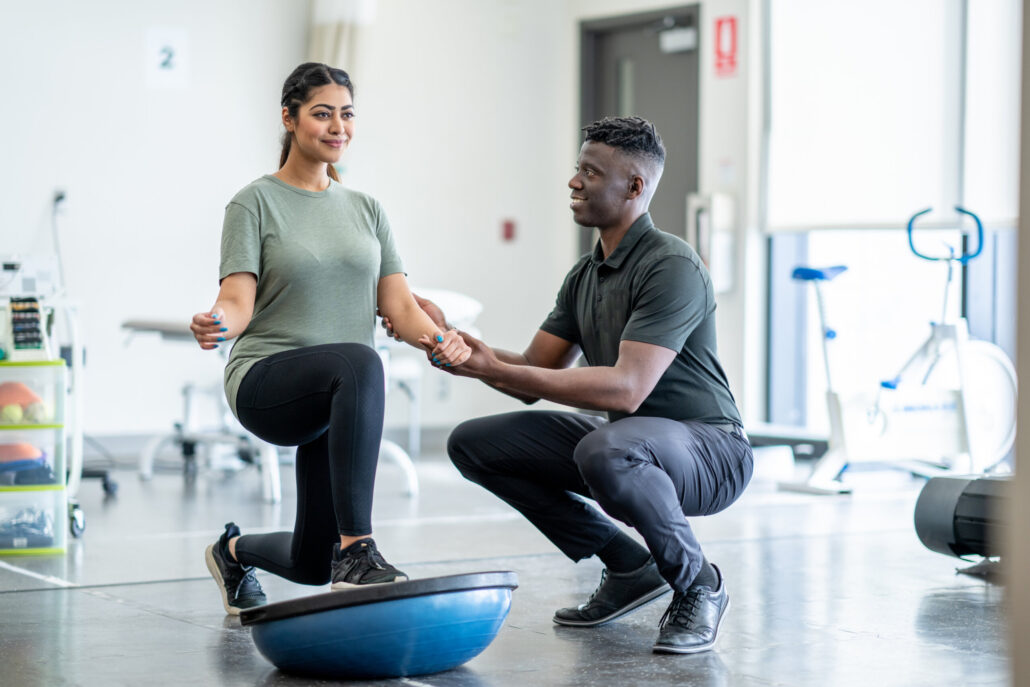A physical therapist explains what you can expect during your first physical therapy appointment.
The phrase “physical therapy” conjures images of exercises and workouts. This conservative treatment can be a critical component of recovery when you suffer a soft tissue joint injury or undergo surgery. Although therapy is centered on doing exercises that are tailored to your injury, the first physical therapy appointment is an injury evaluation. This initial appointment lays the groundwork for your treatment. Physical therapist and manager of Summit’s physical therapy program Nate Riess describes what you can expect during your first appointment and explains why your initial evaluation is so important.
The focus of your first physical therapy appointment
“The initial appointment is different from the therapy sessions that come after,” explains Riess. “Our focus during the first physical therapy appointment is what we call a new evaluation. We take a thorough history. If you have knee pain, for example, how did you injure your knee? One person may have stepped out of a car, twisted a knee, and felt immediate pain. Another person may have experienced gradually increasing pain without any injury. We’ll discuss the factors that irritate your knee and the activities that cause pain. Some patients are bothered by walking or squatting or climbing stairs. These subjective details are very important to help us understand what’s going on.”
Riess also talks with you to identify and understand any functional limitations. “I want to know how your injury has affected your life,” he explains. “Patients report issues like an inability to walk the dog, use stairs, or wash floors. These activities might seem inconsequential, but if they matter to you, they matter to me. Your limitations and objectives drive your goals. Whether you want to walk a dog again or train for a marathon, your goals become our therapeutic objectives.”
Preparing for your first physical therapy appointment
For the first appointment, Riess suggests comfortable clothing that allows you to move freely. “Athletic clothes, gym wear, shorts, or sweats are fine,” says Riess. “But we know this isn’t possible if you are coming straight from work. That’s why we supply shorts you can change into when you arrive. Shorts are particularly important for knee or ankle issues, so we can visually see and evaluate the joint.”
The appointment includes an objective exam
“Once we’ve completed the medical history and subjective exam, we do an objective exam,” explains Riess. “We palpate your joint and check for range of motion, strength, structural damage, and any instabilities. There are special tests that we might perform to help rule certain conditions in or out. If the problem is in your knee, we may evaluate the hip joint above the knee and the ankle joint below too. That’s because hip strength or ankle instability may be playing a role in your knee pain. In short, we follow your symptoms to determine where the pain originates.”
Designing a treatment plan
The subjective and objective evaluations guide the design of your tailored treatment plan. “We’ll talk about how often you need to come to therapy, and explain what you can expect as treatment progresses,” says Riess. “The number of visits you’ll need will evolve as we work together. If we see progress faster than expected, we’ll probably reduce the frequency and number of visits.”
Every therapy program includes assigned home exercises
“In addition to scheduled therapy sessions with us, we give you a home exercise program,” explains Riess. “We assemble select exercise handouts into a booklet for you to take home. Each handout includes a picture and exercise description. It tells you how many repetitions to do, and how often a day and how often per week you need to do your exercise. We may have additional at-home suggestions as well—like tips to control swelling.”
Questions discussed during the physical therapy appointment
“Patients always want to know how often they need to do their exercises and how long it’s going to take to get better,” says Riess. ”Often, they want to know if there are other things they should be doing at the gym. I’m happy to answer these questions. I also make it a point to help patients understand what’s causing their pain.”
When should you see a physical therapist?
“Often, people think of a physical therapy appointment as something that happens after they see their doctor,” notes Riess. “If it takes time to get in to see your doctor, this can be frustrating. That’s why I want people to know that they can speed up that timeline by going directly to a physical therapist first. I advise people to check with insurance if they want to start with me. That’s because some insurance policies require a physician referral before they’ll cover therapy.
“My message is that we want to be a partner with our patients to help them through their issues. If you are more comfortable being referred by your doctor, that’s great. If you want to see me right away to start addressing your pain, I’m here for you. And if you come in, and I’m not sure what’s causing your pain, I’ll refer you to the right Summit specialist for your condition.”
Riess is proud of the relationships Summit physical therapists have with their patients. “We treat a wide variety of conditions,” he says. “Some patients come back to us repeatedly as they experience challenges with acute injuries or issues related to aging. We get to know our patients well; they become part of the Summit family. I firmly believe that physical therapists are a great resource as part of your overall healthcare team.”
Most physical therapists receive doctorate training
“People may be surprised to learn that most physical therapists at Summit Orthopedics have a doctoral degree,” observes Riess. “By 2000, almost all academic physical therapy education had transitioned to a doctoral program. That means that physical therapists earn a four-year undergraduate degree and then spend an additional three years in a physical therapy doctoral program. This rigorous academic program encompasses technical training in orthopedics, cardiovascular medicine, neurology, and geriatrics. Further, doctoral program requirements include approximately one year of supervised clinical internship work in specialty practices.”
Many of Summit’s physical therapists are themselves clinical instructors. “We train interns from St. Kate’s Physical Therapy Program and the Concordia St. Paul Physical Therapy Program,” says Riess. “This training is done on our own time, and we see it as a great way to give back to our profession and our community.”
Riess’s tips to find the right physical therapist
Summit’s physical therapy providers offer a depth and breadth of resources for some very specialized conditions. “If you are a runner, our website tells you which therapists work with runners,” says Riess. “Three of our therapists treat women’s health issues, including post-pregnancy incontinence and pelvic pain. We also offer specialties in vertigo and TMJ conditions.”
- Summit website. “Our website is a great patient resource for specialized therapists,” says Riess. “All of our physical therapists are listed with their clinical interests and specialties.”
- Summit schedulers. “You could also ask our scheduler to direct you to a specific specialist when you call for a physical therapy appointment,” suggests Riess. “I encourage you to explain what you are looking for. We’ll make sure you get to the person who is best suited to treat your condition.”
The physical therapists at Summit Orthopedics are a valuable community resource. “Our physical therapists are very knowledgeable providers,” says Riess. “They have become a great touchpoint for a lot of our patients. With the ability to schedule your own physical therapy appointment, we give you easy, personable access to treatment for a wide range of conditions.”
Summit Orthopedics supports healthy communities
Community health flourishes when specialized orthopedic care is conveniently available close to home. Summit Orthopedics is proud of our fellowship-trained subspecialty teams offering the full spectrum of orthopedic expertise in bone, tendon, ligament, muscle, and joint conditions—in addition to our wellness, prevention, and rehabilitation services. We have the expertise to proactively improve fitness, evaluate discomfort, and deliver personalized treatment to quickly and safely return you to the lifestyle you love.
Start your journey to a healthier, more active self. Visit our Facebook page to learn about our wellness services and schedule a free wellness consultation online. Find your orthopedic expert, request an appointment online, or call us at (651) 968–5201 to schedule a consultation.
Summit has convenient locations across the Minneapolis-St. Paul metro area, serving Minnesota and western Wisconsin. We have state-of-the-art centers for comprehensive orthopedic care in Eagan, MN, Plymouth, MN, Vadnais Heights, MN, and Woodbury, MN, as well as additional community clinics throughout the metro and southern Minnesota.
More resources for you
- Easy Hip Warm-Up Stretches
- Delayed Joint Replacement? 4 Tips for Home Care
- Can Physical Therapy Treat Foot Pain?
- Summit Orthopedics: Now in Lakeville

